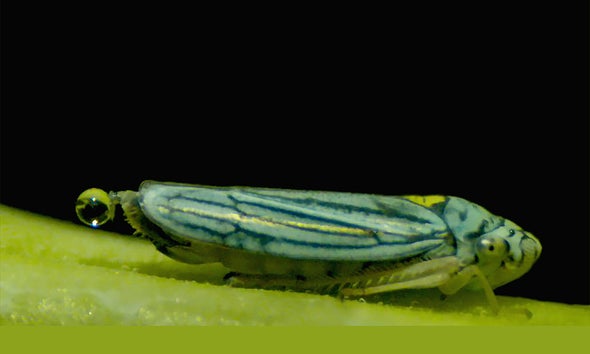
Glassy-winged sharpshooters (Homalodisca vitripennis) are stout insects who sport bulging yellow eyes and transparent wings streaked with red. They use their strawlike mouth to siphon water and minerals from plants’ xylem, the system of tubes that transports both substances from the roots through growing tissues. Xylem sap is a nutrient-poor concoction: it is 95 percent water—a similar water content to celery. As a result, sharpshooters must continually suck more of the fluid to gather enough calories. And the liquid that goes in must come out.
Georgia Institute of Technology biomolecular engineer Saad Bhamla and his Ph.D. student Elio Challita became intrigued after observing sharpshooters relieving themselves in the researchers’ respective backyards in Atlanta. “You never stop to think about how insects pee,” Challita says. “The unusual things about sharpshooters is that they pee one drop at a time.”
Unlike their xylem-guzzling relatives cicadas, sharpshooters don’t spray their waste out in a stream. This is because of their diminutive size. The pushpin-size insects, who expend most of their energy vacuuming up xylem fluid, lack the energy required to produce a stream, forcing them to pee in a more creative way. Like a pump inflating balloons, sharpshooters form individual drops of pee on a flexible structure on their backside called an anal stylus. As a sharpshooter’s stylus rotates along a hinge, it flings the droplets away to keep the insect’s drinking spot clean and potentially to help it avoid detection by predators that may be attracted to the scent of the urine.
To analyze sharpshooters’ bizarre bathroom behavior, Bhamla and Challita used high-speed imaging to capture footage of five of the insects launching droplets of pee and took micro CT scans of their stylus. Like a catapult, the stylus is rigged with springs and latches and can accelerate more than 40 times faster than a sprinting cheetah.
At first, the researchers were puzzled to find that those droplets actually move at speeds that are roughly 40 percent faster than the stylus that launches them. According to Bhamla, if a pitcher hurls a baseball at 100 miles per hour, their hand must also move at that speed during the throwing motion.
But unlike baseballs, liquid droplets are pliable. Before they’re flung, the droplets compress, storing up energy in surface tension. When the compressed droplets go flying, that stored energy is released. Bhamla says that when the movement of the stylus is synced up to the compression of the pee droplets, the accelerated launch is reminiscent of an Olympic diver perfectly timing their jump off a diving board.
The phenomenon, where an oscillating surface such as a sharpshooter’s stylus launches a drop of liquid at a higher speed, is superpropulsion. It helps the sharpshooters conserve energy as they efficiently fling droplet after droplet. Researchers have found that catapults launching droplets can utilize superpropulsion to create 250 percent more energy than when they fire rigid objects, making the phenomenon an intriguing method for conserving energy in propulsion engines such as those on rockets.
According to the researchers, this is the first time that superpropulsion has been observed in a biological system. “It’s amazing because physicists and engineers have demonstrated the idea of superpropulsion in the lab, but this amazing organism came up with the idea hundreds of thousands, if not millions, of years before us,” Bhamla says.
While sharpshooters are the only insects known to harness superpropulsion, lots of tiny critters have mechanisms for ultrafast movement, according to Aimy Wissa, a mechanical engineer at Princeton University, who studies how click beetles launch themselves in the air without using their legs. “There’s a big range of organisms that use latches and springs, including things like fleas,” says Wissa, who was not involved in the new research. “Nature has evolved these mechanisms to circumvent some of the limitations of muscles or volume constraints because some of these insects are so small.”
The practice of pitching bodily waste has been seen elsewhere in the animal kingdom: Several other species have been described as “butt flickers” and “turd hurlers.” One example is the skipper caterpillar, which can shoot solid pellets of its waste, known as frass, over a distance up to 38 times its body length to keep predators off its tail.
Sharpshooters’ penchant for efficiently ditching liquid may also make them an engineering darling in the human world. Bhamla and Challita say that similar methods of superpropulsion could one day help wearable devices such as smartwatches remove moisture or prevent droplets from fogging up glasses. And it’s all because of the sharpshooters’ perpetual need to pee.
ABOUT THE AUTHOR(S)
Jack Tamisiea is a science journalist based in Washington, D.C., who covers natural history and the environment. Follow Tamisiea on Twitter @jack_tamisiea

